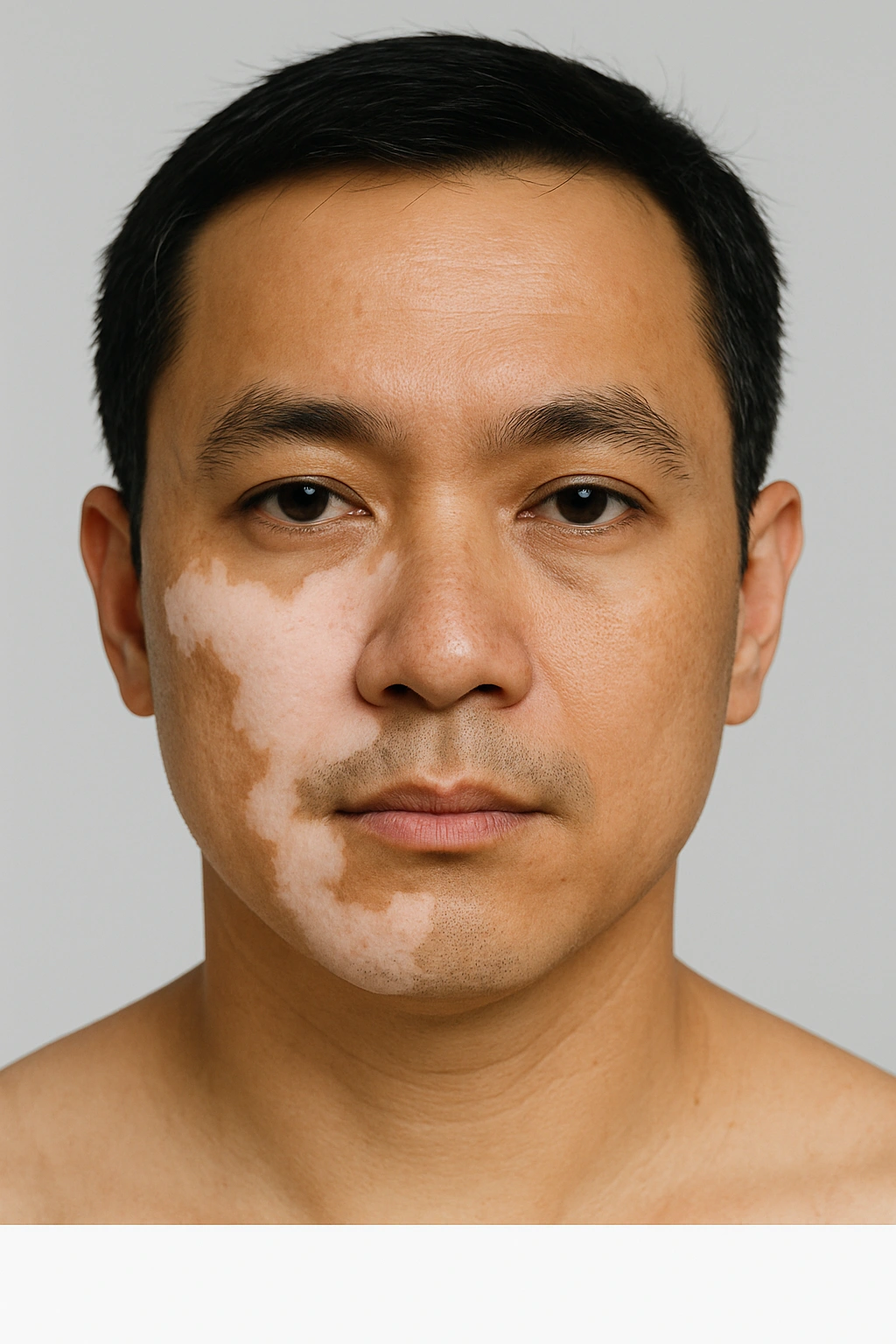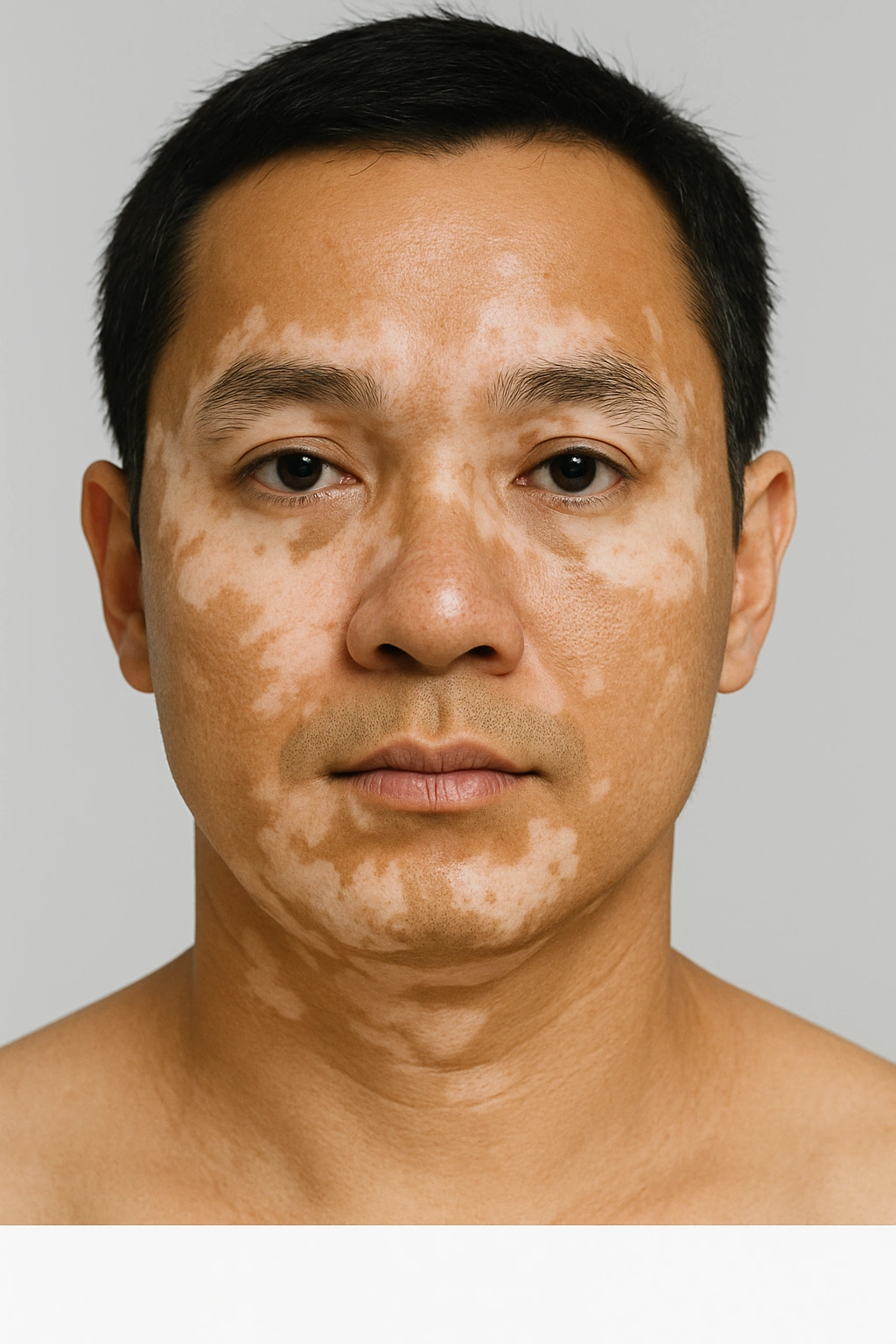What is Vitiligo?
Understanding the Condition

UNDERSTANDING VITILGO
A Skin Condition Beyond Just Color Loss
Vitiligo, is a long-term (chronic) skin condition that causes an area of the skin to lose its colour (pigmentation). Melanocytes (the skin cells that make pigment) which results in the area looking white or pink in appearance.
Vitiligo usually starts with pale patches of skin that gradually turn white. The centre of a patch may be white, with paler skin around it, the edges of the patch may be smooth or irregular. This condition varies from person to person. Some patients may develop only a few white patches, while others may experience larger patches that cover extensive areas of skin.
Additionally, the lack of pigment in the affected areas can cause the hair to turn white or gray.1-3
Common areas of skin affected by vitiligo

Often one of the first areas where vitiligo appears, especially on knuckles and fingers.
Vitiligo may spread along the forearms and elbows in noticeable patterns.
Frequently affects areas around the eyes, mouth, and forehead.
Can cause loss of pigment inside the mouth, lips, or nose.
Patches commonly form around toes, ankles, and the tops of the feet.
Types of vitiligo
There are two main types of vitiligo, non-segmental and segmental vitiligo. The most common is the non-segmental type, wherein symptoms typically appear as symmetrical white patches on both sides of the body. Segmental vitiligo is much less common, with white patches appearing on only one segment or side of the body.2,4


UNDERSTANDING VITILGO
Causes of vitiligo
Normal skin color is determined by melanin produced by skin cells known as melanocytes. In vitiligo, a deficiency of functional melanocytes leads to insufficient melanin, resulting in white patches on the skin. Researchers continuously investigating the influence of heredity and genetics on the causes of vitiligo.1-3


UNDERSTANDING VITILGO
Autoimmune Conditions
In autoimmune conditions, the immune system malfunctions and mistakenly attacks the body’s healthy cells and tissues. Non-segmental vitiligo, which is the most prevalent type, is thought to be an autoimmune disorder.1,2
Triggers include:2,3
- Stress
- Skin damage (such as severe sunburn)
- Exposure to certain chemicals
Diagnosis
Your doctor will ask about your family medical history and conduct a thorough physical examination of the affected areas of your skin. The evaluation may include a careful assessment of your skin.1,2
Wood Lamp – Vitiligo Diagnosing Tool
The Wood’s lamp is a frequently used tool for diagnosing vitiligo. This ultraviolet light causes the affected areas to appear bright and chalky. Under ultraviolet light, the patches of vitiligo become more visible, helping to differentiate vitiligo from other skin conditions.1,2
Other tests include:1
- Blood tests to check for other autoimmune diseases
- A Skin biopsy, in which a small sample of skin will be examined under a microscope for the missing melanocytes in the depigmented skin tissue

MANAGEMENT AND TREATMENT
Vitiligo is typically not harmful to your health. However, it’s important to consult your healthcare provider for tailored treatment recommendations. Medical intervention may help slow the progression of pigmentation loss, promote regeneration of melanocyte, and potentially restore skin color.1,2
Topical Medications
- Corticosteroids
- Calcineurin inhibitors
- Janus Kinase (JAK) inhibitors
Light therapy
Light therapy exposes your skin to a type of ultraviolet (UV) light, which may restore your natural skin color
Surgery
Surgery may be an option for some patients, which include skin graft and cell transplant
Depigmentation therapy
Depigmentation removes the remaining color on the skin and is rarely used
Know more about JAK inhibitor
The goals of vitiligo treatment include stabilizing the condition, achieving repigmentation, and preventing recurrence. Recently, JAK inhibitors have been explored as a promising therapeutic option for vitiligo. The activation of the JAK-STAT pathway and the inflammatory cycle led to the destruction of melanocytes, resulting in depigmentation.3
JAK inhibitors block the JAK-STAT pathway, which reduces JAK-STAT signaling and suppresses inflammatory responses. This helps to prevent the body’s attack on melanin-producing cells. Therefore, the JAK-STAT pathway presents a compelling target for therapeutic intervention.3,4
Clinical studies on the effectiveness of topical JAK inhibitor have shown promising results. In clinical trials, the application of a JAK inhibitor cream resulted in greater repigmentation in non-segmental vitiligo compared to the control group over a 52-week period.*5
Pathophysiology of vitiligo and role of JAK inhibitors3

The process of repigmentation
Repigmentation may take place once the inflammatory response is suppressed and melanocyte precursors are stimulated to proliferate, migrate, and mature into melanocytes, which can gradually start to produce pigment.6
Repigmentation is a gradual process influenced by the severity and location of lesions on the body. The main sources of melanocytes and melanocyte precursors are the hair follicles and the epidermis at the lesional borders. Repigmentation tends to occur more rapidly in areas with a higher density of hair follicles. However, the molecular and cellular mechanisms driving repigmentation are still not fully understood.6

Depigmentation

Repigmentation
*There are two phase 3, double-blind, vehicle-controlled trials that involved patients 12 years of age or older who had non-segmental vitiligo with depigmentation covering 10% or less of total body-surface area.
JAK: Janus Kinase; STAT: signal transducer and activator of transcription.

LIVING WITH VITILIGO
Caring for Skin and Self
Melanin in the skin plays an essential role in protecting it, and individuals with vitiligo are deficient in melanin, making them more sensitive to sunlight. Therefore, it is important to take care of your skin to prevent sunburn. 1,2
Individuals with vitiligo may feel embarrassed about the appearance of their skin. Some may experience emotional challenges related to this condition. It’s important to talk to a healthcare provider if you or someone you care about is struggling emotionally.1,3
Take the Vitiligo Impact on Quality of Life Questionnaire
Have Questions About Vitiligo?
Frequently Asked Questions
Living with vitiligo can come with uncertainty, especially if you’re newly diagnosed or supporting someone who has it. This FAQ section is here to help you better understand the condition, how to care for your skin, and where to find support.
Is vitiligo contagious?
Vitiligo is not contagious and not spread from person to person through physical contact.1
Is vitiligo painful?
Vitiligo is not painful. However, the lighter skin affected by vitiligo can be more susceptible to sunburn, so it is important to protect yourself from the sun.1
Is there a cure for vitiligo?
Newer advances in treatments are now available to help restore lost skin colour. Talk to your dermatologists are about it.
Are there risks for other health conditions?
If a person has one autoimmune disease, they are at a higher risk of developing another. Individuals with vitiligo may be more susceptible to other autoimmune conditions that affect the immune system. Consulting with a healthcare professional can help you cope with the disorder.1,2
